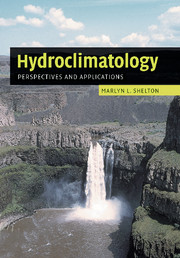Book contents
- Frontmatter
- Contents
- Preface
- 1 The realm of hydroclimatology
- 2 The climate system and the hydrologic cycle
- 3 Measuring hydroclimate atmospheric components
- 4 Measuring hydroclimate terrestrial components
- 5 Remote sensing and hydroclimate data
- 6 The runoff process and streamflow
- 7 Hydroclimate spatial variations
- 8 Hydroclimate temporal variations
- 9 Floods: the hydroclimatic extreme of excessive moisture
- 10 Drought: the hydroclimatic extreme of deficient moisture
- References
- Index
7 - Hydroclimate spatial variations
Published online by Cambridge University Press: 06 July 2010
- Frontmatter
- Contents
- Preface
- 1 The realm of hydroclimatology
- 2 The climate system and the hydrologic cycle
- 3 Measuring hydroclimate atmospheric components
- 4 Measuring hydroclimate terrestrial components
- 5 Remote sensing and hydroclimate data
- 6 The runoff process and streamflow
- 7 Hydroclimate spatial variations
- 8 Hydroclimate temporal variations
- 9 Floods: the hydroclimatic extreme of excessive moisture
- 10 Drought: the hydroclimatic extreme of deficient moisture
- References
- Index
Summary
Spatial scale
Hydroclimate displays notable variations from place to place in response to multiple influences exerted by the Earth's climate system on the hydrologic cycle. These spatial variations exist on a continuum and produce an infinite number of hydroclimatic expressions. Various constructs are employed to categorize segments of the continuum in an effort to achieve understanding of hydroclimate, and these constructs embrace scale issues that are connected fundamentally with the measurement process. Scale manifests itself in heterogeneity explicitly through the measuring instrument and implicitly through the physical environment (Cushman, 1986). In many instances, the spatial variability of one process greatly exceeds the spatial variability of another process even though both are important to hydroclimate. This is illustrated by contrasting the spatial variability in atmospheric forcing apparent in precipitation heterogeneity with the mosaic-like pattern of spatial variability in runoff due to changing boundary conditions associated with the distribution of biotic, pedologic, and geomorphic features (Shelton, 1989).
Meteorologists concerned with dissimilar scales of atmospheric behavior ranging from global to local reduce the entire range of phenomena into a small number of categories based on observational and analytical techniques needed to describe and understand the phenomena. Recognizing that short time-scale phenomena tend to occur on a small space-scale and long-term phenomena affect large areas, meteorologists focus on weather analysis at the synoptic or regional scale that embraces units the size of nations in Europe or states in the United States.
- Type
- Chapter
- Information
- HydroclimatologyPerspectives and Applications, pp. 212 - 261Publisher: Cambridge University PressPrint publication year: 2008



